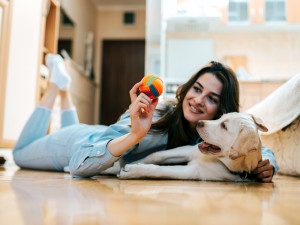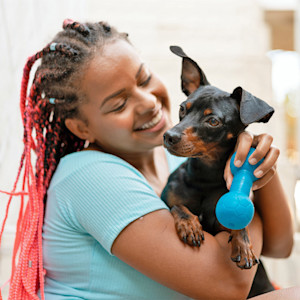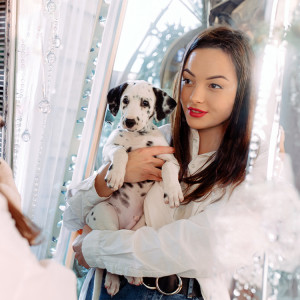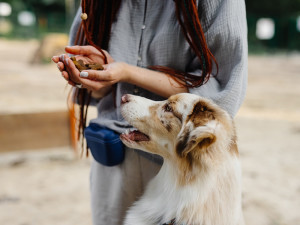Dogs Care More About the Texture of Something Than the Shape, New Study Finds
It’s one way canine cognition differs from human cognition.
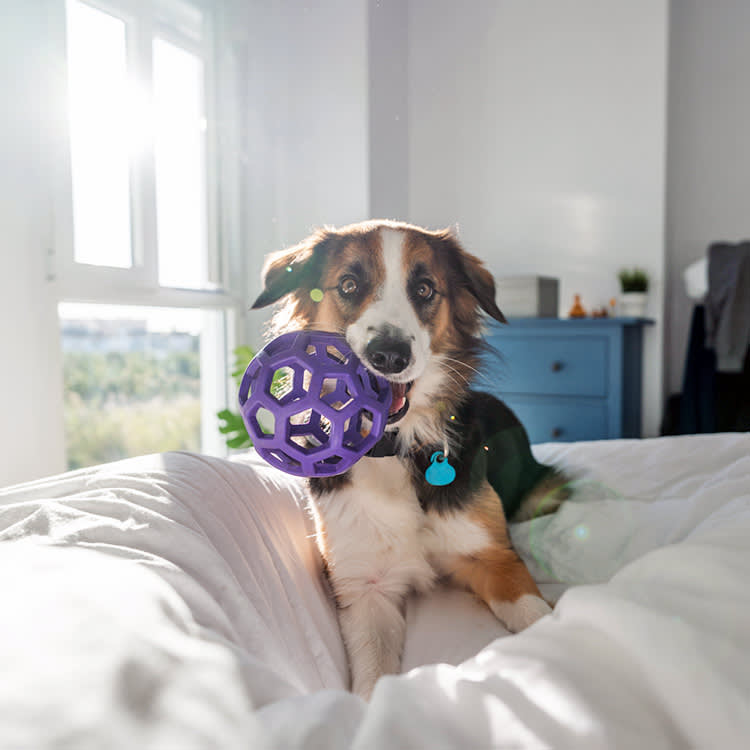
Share Article
Pups and humans have a surprising amount in common when it comes to cognition (our brainwaves literally syncopens in new tab when we stare into each other’s eyes, for one), but for the most part, what’s going on in those puppy heads is still a mystery. In a new study,opens in new tab researchers found a unique quirk in canine perception. Unlike humans, when identifying objects, dogs prioritize texture over shape.
In humans, the meaning of words is most significantly linked to the shape of an object. In a 1988 studyopens in new tab, researchers found that when humans connect a name to a new object, “they generalize the meaning of the new name to objects that are similar in shape, but not to objects that are similar in size or texture,” Claudia Fugazza, the new study’s lead author, summarized. For example, children naturally learn to associate the word “cat” with a cat’s shape rather than the cat’s fur, and this allows them to group different types of cats into one category. The phenomenon is called “shape bias.”
To explore whether or not dogs exhibit shape bias, scientists trained 25 dogs to retrieve a specific object out of a larger set of distractors. The dogs learned to associate the target object with the name “Dax.”
The various objects were crafted out of foam to resemble cylinders, triangles, or rectangles. They were then covered in different textured materials: velcro, duct tape, or uncovered foam. Color, weight, and volume were identical.
How much do you spend on your pet per year?
After the pups were trained to discriminate the desired object, they were given a test. In four trials, they were provided two objects: one with the same shape as the object they had learned to retrieve, and one with the same texture as the object they had learned to retrieve.
They found that when choosing between the two objects, dogs often approached the object with a similar shape first. However, after making contact with the objects, they ultimately retrieved the object that matched in texture. “This suggests a reliance on visual cues for initial assessment and tactile cues for final discrimination,” Fugazza wrote.
That doesn’t mean that dogs don’t show shape bias at all — just that it isn’t the most important factor in their decision making. The researchers point out that if they had based their conclusion on which object the dogs approached rather than which one they retrieved, they would have concluded that dogs do show shape bias. “Dogs may show a shape bias that is reminiscent of that observed in human children only when using the visual modality, but not when all senses can be deployed to solve the task,” Fugazza wrote.
The study opens the door to understanding more about how dogs perceive the world. “Understanding how non-human animals generalize the properties of objects can provide insights into the evolutionary processes and cognitive mechanisms that influence this bias,” Fugazza wrote.
In the meantime, if your pup tears their favorite toy to shreds and you have the option to replace it with one that looks the same or feels the same, decide based on texture. Your pup will appreciate the effort.

Sio Hornbuckle
Sio Hornbuckle is the Assistant Editor at Kinship, where they frequently write for the site. As a writer, they specialize in pet news, animal science, and pop culture. They live in New York City with their cat, Toni Collette.
Related articles
![Woman and her dog playing with a ball.]()
Your Dog Actually Knows the Words for Familiar Objects, Study Finds
Time for a “Proud Parent of a Canine Honors Student” bumper sticker.
![Woman holding her small black dog with his favorite toy.]()
Dogs Can Remember Names of Toys 2 Years After Seeing Them, New Study Finds
Some dogs have impressive long-term memories.
![Brown, half breed dog sitting on a chair next to his owner, a blonde stylish woman wearing a brown smart suit.]()
Your Dog Can Read Your Mind, Kind Of
Researchers say dogs actually have a pretty good sense of what we’re thinking.
![Woman and her Dalmatian puppy look in the mirror at their reflections.]()
Do Dogs Recognize Themselves in the Mirror?
Here’s why dogs know who they are more by smell than by sight.
Can Your Dog Tell When You’re Lying?
They can sniff out where you’ve hidden their treats, but deception is another matter.
![a dog looking at a person holding multiple treats]()
So Apparently, Your Dog Might Be Able to Count
This study finds that dogs can process numbers in a similar fashion to their humans.
